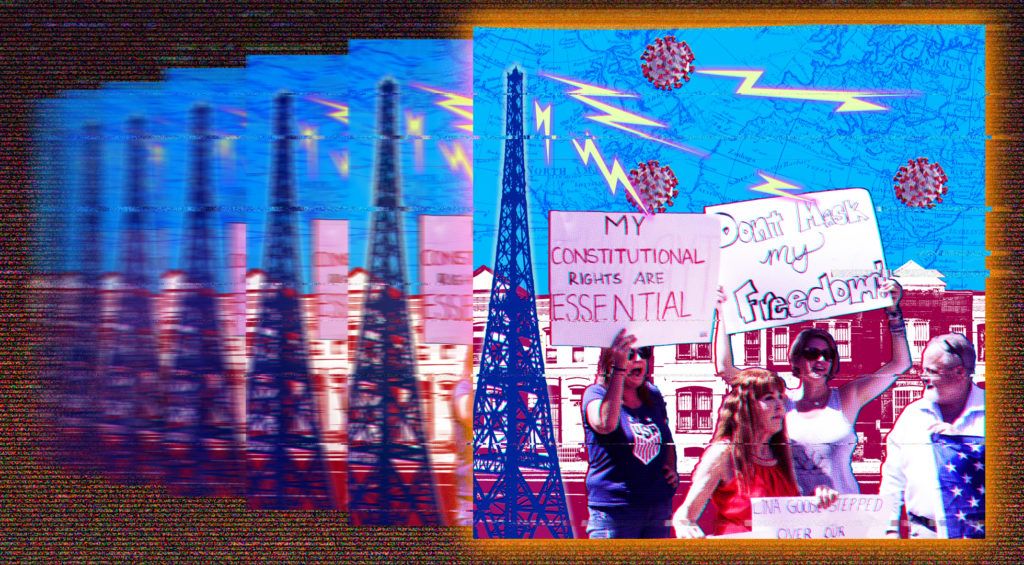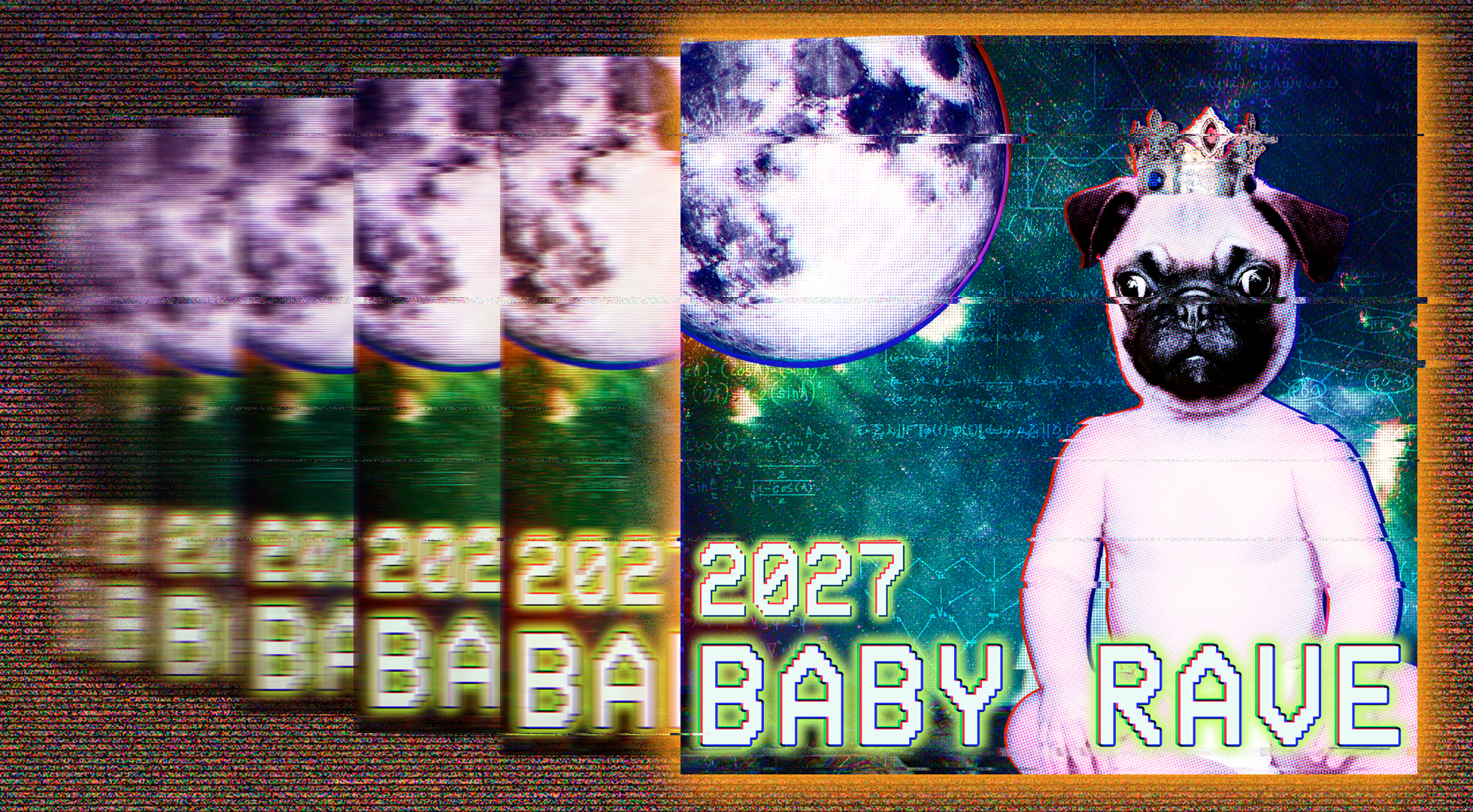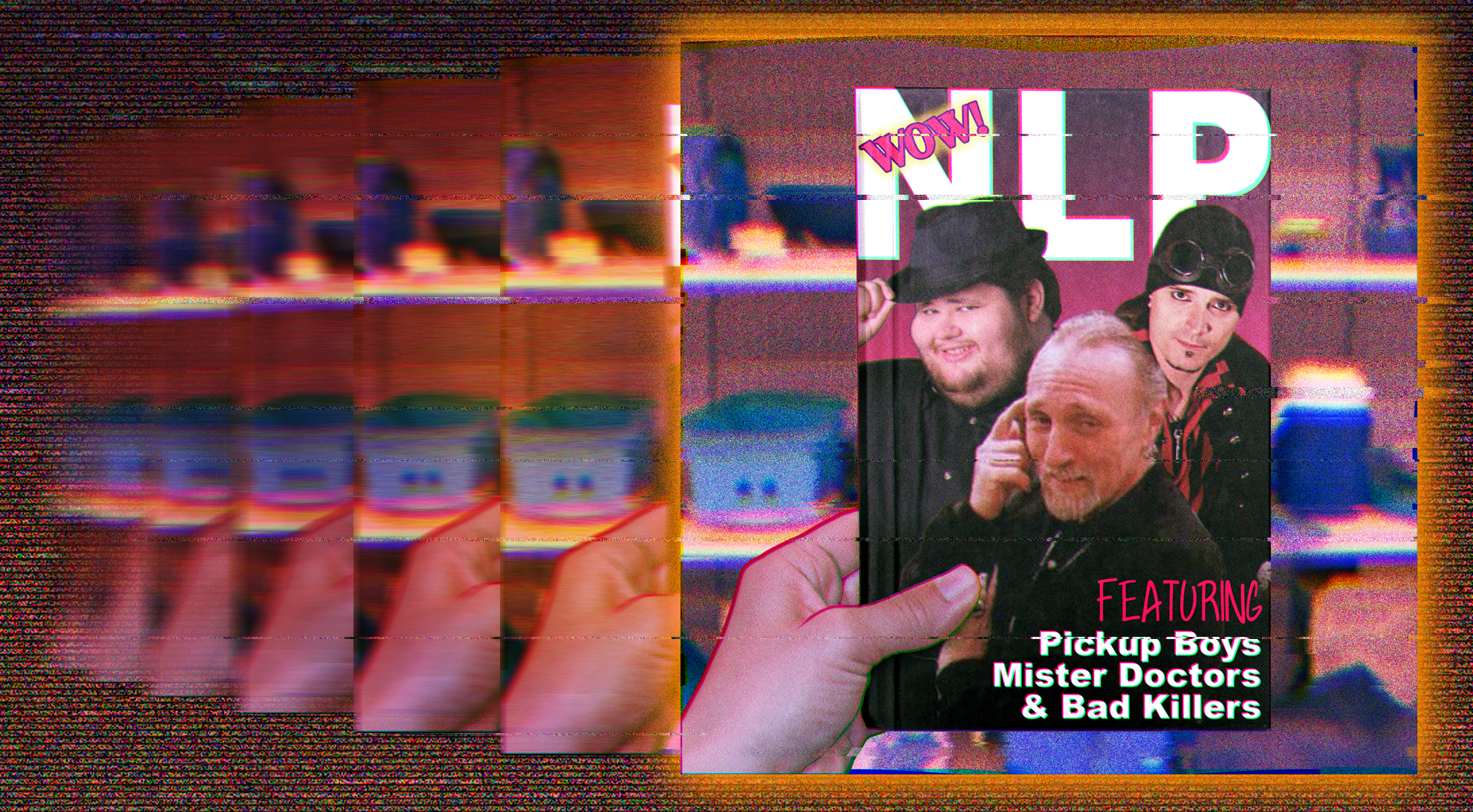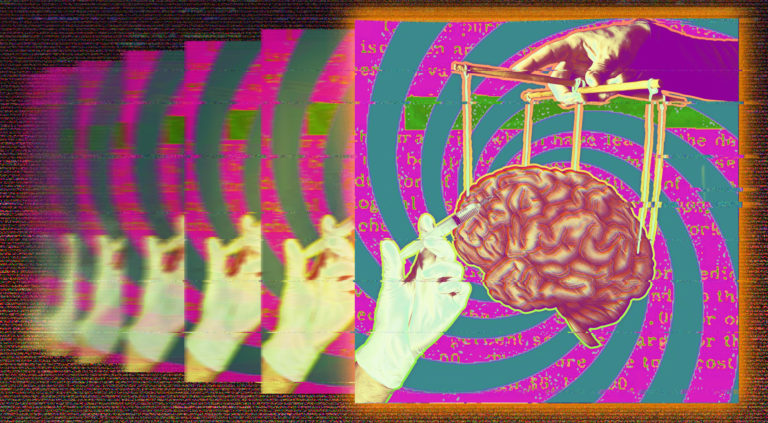Before the Coronavirus
Adam Weishaupt - The OG Illuminati Cult Daddy and Total Fucking Narcissist (TM)Oh mortal man, is there anything you cannot be made to believe? Of all the means I know to lead men, the most effectual is a concealed mystery. The hankering of the mind is irresistible.
Listen, we aren’t the first generation to be totally fucking stupid in the face of a pandemic. Humans have been acting like lunatics in the face of anxiety for thousands of years and we will continue reaching for meaning in spite of logic until we’re blighted from the earth. Oh shit, I got heavy. Let’s keep it light with a look at the Black Death Plague…wait, that’s not light…oh hell, let’s just get into it.
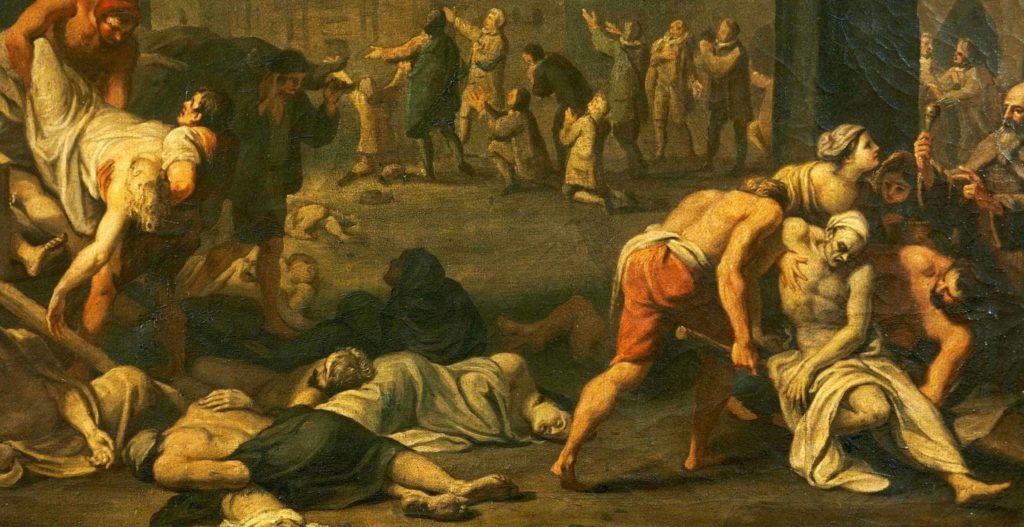
Bubonic Plague: 1347 to 1351
The Real Story
The Black Death was a devastating global epidemic of bubonic plague that struck Europe and Asia in the mid-1300s. The plague arrived in Europe in October 1347, when 12 ships from the Black Sea docked at the Sicilian port of Messina. People gathered on the docks were met with a horrifying surprise: Most sailors aboard the ships were dead, and those still alive were gravely ill and covered in black boils that oozed blood and pus. Sicilian authorities hastily ordered the fleet of “death ships” out of the harbor, but it was too late: Over the next five years, the Black Death would kill more than 20 million people in Europe—almost one-third of the continent’s population.
Even before the “death ships” pulled into port at Messina, many Europeans had heard rumors about a “Great Pestilence” that was carving a deadly path across the trade routes of the Near and Far East. Indeed, in the early 1340s, the disease had struck China, India, Persia, Syria and Egypt.
“In men and women alike,” the Italian poet Giovanni Boccaccio wrote, “at the beginning of the malady, certain swellings, either on the groin or under the armpits…waxed to the bigness of a common apple, others to the size of an egg, some more and some less, and these the vulgar named plague-boils.”
Blood and pus seeped out of these strange swellings, which were followed by a host of other unpleasant symptoms—fever, chills, vomiting, diarrhea, terrible aches and pains—and then, in short order, death. The Bubonic Plague attacks the lymphatic system, causing swelling in the lymph nodes. If untreated, the infection can spread to the blood or lungs.
Today, scientists understand that the Black Death, now known as the plague, is spread by a bacillus called Yersina pestis. The bacillus travels from person to person through the air, as well as through the bite of infected fleas and rats. Infected rats would make a home on the ship, allowing the disease to spread.
The plague had a resurgence a few years later, but officials in the port city of Ragusa spotted it and kept arriving sailors in isolation until it was clear they weren’t infected. The sailors were initially held on their ships for 30 days (a trentino), a period that was later increased to 40 days, or a quarantine—the origin of the term “quarantine”.
According to The World Health Organization, there are still 1,000 to 3,000 cases of plague every year.
Source: https://www.history.com/topics/middle-ages/black-death#:~:text=The Black Death was a,the Sicilian port of Messina.
Conspiracy Theories
Because they did not understand the biology of the disease, many people believed that the Black Death was a kind of divine punishment—retribution for sins against God such as blasphemy and greed.
Jews had long been relegated to unreliable and “immoral” occupations such as money lending, thought to be a profession of the greedy. It was thought that Jews were already sinners, having rejected Christ as the Messiah, and they could always deny their Jewish faith and become Christians, so it was ok to make them sin more in professions like money lending. They were also ousted from the main population and forced to live in walled off “ghettos”. Separate from the rest of the population, and with cleanliness being a key aspect of some of their religious practices, the presence of rats and other pests weren’t as much of a problem in the Jewish communities – the spread of the plague very well could have been less of an issue in the confines of the Jewish ghettos due to this forced quarantine. Some of the cities noticed that while they were facing more deaths and illnesses by the day, Jews seemed to be absent from the suffering of the Bubonic Plague (totally not true, there are historians that say Jews were just as likely to die from the plague as the rest of the population, but whatever). A Conspiracy Theory quickly circulated that a Jewish conspiracy to kill all Christians through bio-warfare was underway.
Franciscan Friar Herman Giger said: “Some say it that was brought about by the corruption of the air, others that the Jews planned to wipe out all the Christians with poison, and had poisoned wells and springs everywhere.”
Many Jewish people were tortured and forced to confess and name others to suffer punishment. Because people believed this nonsense, many cities closed their wells and started getting their water from the river, making them more susceptible to becoming infected. As the infection continued, the city of Savoy sent a notice to several other cities of the Jewish conspiracy to eradicate all the Christians by poisoning the wells. People began rounding up their entire Jewish populations and executing them. In a particularly cruel instance, one city saved a few Jewish people to execute on the third day of the Christian Nativity…something I’m sure Jesus would have been so proud of.
The church and some monarchs tried to intervene on behalf of besieged Jewish communities. They did so for practical reasons, chief among them the fear that widespread mob violence against Jews could lead to contempt for all forms of authority and that their various bases of power would be next in line. In several decrees—papal bulls—Pope Clement VI attempted to put a halt to anti-Jewish violence, noting the illogic of Jews spreading disease through poisoning of wells. “Throughout many parts of the world the same plague, by the hidden judgment of God, has afflicted and afflicts the Jews themselves and many other races who have never lived alongside them,” he wrote. In this, Clement was aided by the research of his personal physician Guy de Chauliac, who argued from his own treatment of the infected that the Jews were not to blame.
A lot of people thought that since they had killed all the Jews in their cities, they didn’t have debt anymore. King Charles I was like, “ummmm…the Jews paid me income tax, you killed all of them, bitch better have my money.” So the assholes were left with more debt than they had to begin with. THAT’S WHAT YOU FUCKING GET, YOU GREEDY ANTISEMITES.
The Body Count
The persecution of the Jews during the plague created the most casualties of all time outside the Holocaust. It’s hard to tell how many were killed, but at least 210 communities were wiped out and some historians are still trying to figure out if more Jews were killed by the plague or by the persecution.
The overall plague body count is difficult to ascertain, but various sources cite it as between 25-50 million.
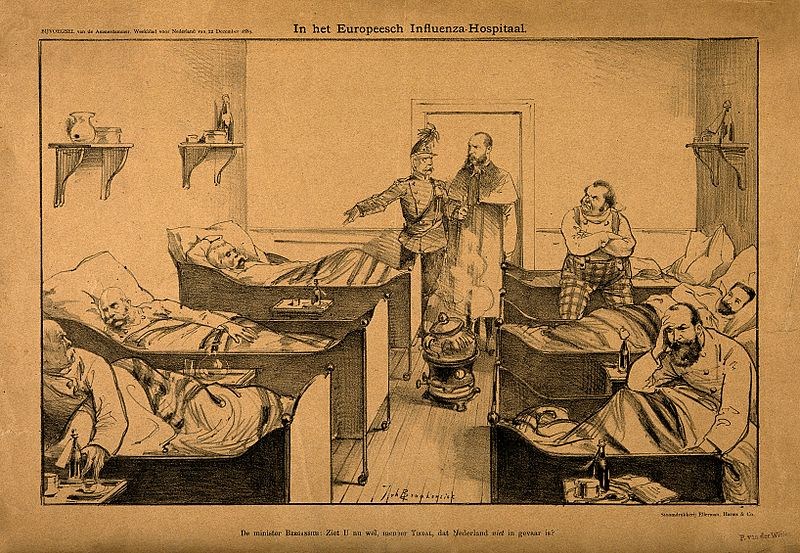
Russian Flu: 1889-1890
The Real Story
The 1889–1890 flu pandemic, also known as the “Asiatic flu” or “Russian flu”, was a deadly influenza pandemic that killed about 1 million people worldwide. It was the last great pandemic of the 19th century.
The most reported effects of the pandemic took place October 1889 – December 1890, with recurrences in March – June 1891, November 1891 – June 1892, winter 1893–1894 and early 1895.
It is not known for certain what agent was responsible for the pandemic. Since 1950s it has been conjectured to be Influenza A virus subtype H2N2. A 1999 seroarcheological study asserted the strain to be Influenza A virus subtype H3N8. A 2005 genomic virological study says that “it is tempting to speculate” that the virus might have been not actually an influenza virus, but human coronavirus OC43.
The reason for the fast spread of the virus seems to be expansion of modern transportation, such as train lines and transatlantic travel. We also have to remember that scientists wouldn’t discover viruses for another three years, so no one knew why this was happening. Lack of knowledge means no way to know how to help or stop it. At first, they didn’t even know if they should classify it as a contagion, but it’s quick spread made it obvious that it was.
First reported in Bukhara, Russian Empire, in May 1889, by November that year the epidemic had reached Saint Petersburg. In four months it had spread throughout the Northern Hemisphere. Deaths peaked in Saint Petersburg on 1 December 1889, and in the United States during the week of 12 January 1890. The median time between the first reported case and peak mortality was five weeks.
After the SARS epidemic, virologists started sequencing and comparing human and animal coronaviruses, and comparison of two virus strains in the Betacoronavirus 1 species, Bovine coronavirus and Human coronavirus OC43 indicated that they had a most recent common ancestor in the late 19th century, with several methods yielding most probable dates around 1890. Authors speculated that an introduction of the former strain to the human population might have caused the epidemic.
Conspiracy Theories
Conspiracy Theories: Overly-Complicated Self-Soothing
A Boring Buzzfeed Quiz: Are You an Intuitionist or a Rationalist
Before we get into this, let’s see if we can figure out where you fall in the intuitionist or rationalist thought process:
- Would you rather stab a picture of your family five times or put your hand in a bucket of cockroaches?
- Would you rather sleep in laundered pajamas once worn by Charles Manson or pick a nickel off the ground and put it in your mouth?
- Would you rather spend the night in dingy bus station or spend the night in a luxurious home where a family was once murdered?
Researcher Eric Oliver has studied conspiracy theories for a looooong time and he proposes people can somewhat be categorized as intuitionist, rationalist, or a kind of middle ground. To be fair, he says in his studies the majority of people lie somewhere in the middle, being intuitionists on certain thought processes and rationalists on others. Intuitionists are feeling based and react more strongly to symbolism whereas rationalists rely more on the tangible aspects of the world than their feelings or instinctual reaction. I think you can also link this to Top-Down or Bottom-Up Processing.
While most people are pretty balanced in their approach, Oliver says true Intuitionists outnumber true Rationalists 2/1. So, revisiting the questions I asked before, where do you fall in the spectrum?
Intuitionists tend to be heavy believers in spiritualistic-New Age concepts, paranormal, and conspiracy theories. Their thought processes are tied to emotions, so the feeling of uncertainty hits them especially hard. Already, humans do not react well to uncertainty, as we have evolved to think of any uncertainty as potentially critically dangerous, so we like to find the answers as quickly as possible, whether those answers are rooting in tangible evidence or just our “gut feelings.”
Oliver also suggests that the reason it is so difficult to talk people out of their conspiracy theory beliefs is not just because people really feel unsafe (from a biological standpoint) when they are criticized, but also that the language of Intuitionists is so vastly different it’s hard to connect if you aren’t engaging with the same emotion based response. Intuitionists are “bound by heuristics,” a type of judgment shortcut. A good example of a heuristic is the idea of touching a holy relic or touching a cursed item. If a rationalist approach to something feels emotionally costly, an Intuitionist is less likely to engage in it.
Magical Thinking
Magical thinking, the belief that one’s ideas, thoughts, actions, words, or use of symbols can influence the course of events in the material world. Magical thinking presumes a causal link between one’s inner, personal experience and the external physical world. Believing in supernatural or paranormal phenomena seems to indicate susceptibility to conspiracy theories. Often times, people who engage in magical (or intuitive) thinking look for an unobservable force in action and actively reject the observable reality.
Magical Thinking is considered one category of delusions, out of many, to which schizophrenic people are subject. A good example of Magical Thinking in the general population would be the idea of Manifestation. In psychiatry, magical thinking is a disorder of thought content; here it denotes the false belief that one’s thoughts, actions, or words will cause or prevent a specific consequence in some way that defies commonly understood laws of causality. People with OCD often experience a severe form of this, ex: if I never throw away my dog’s shed hair, she will never get sick. A good example of Magical Thinking in the general population would be the idea of Manifestation, as in with your good or bad thoughts, you manifest positive outcomes such as financial gain or negative outcomes such as illness or death.
According to theories of anxiety relief and control, people turn to magical beliefs when there exists a sense of uncertainty and potential danger, and with little access to logical or scientific responses to such danger. Magic is used to restore a sense of control over circumstance. In support of this theory, research indicates that superstitious behavior is invoked more often in high stress situations, especially by people with a greater desire for control.
Illusory Pattern Perception
Humans are built to notice patterns in the world around us. It keeps us safe to notice details that could contribute to danger or success in the future. This is pattern recognition can get a bit out of control, though. There’s a common theme to a lot of conspiracy theories that psychologists call “connecting the dots.” “Connecting the dots” describes attributing meaning or pattern to unrelated events. An example might be: Hillary Clinton lied about her emails, leaked emails could contain secret messages about pedophilic human trafficking rings, Hillary and staff ordered pizza from this place, the pizza place clearly has a secret sex dungeon full of children. In this example, a “secret code” was found in leaked emails, but if you are looking for a code in a lot of texts, you will find what you are looking for. In one video I watched, a person suggested that if you lay out all the text of Moby Dick and evenly spaced the letters, you could find “evidence” that predicts the assassination of JFK, WWII, and the events of 9/11.
Ramsey theory is a mathematical theory that suggests if given enough elements in a set or structure, some interesting pattern among them is guaranteed to emerge. The idea is that disorder is more probable, but complete disorder is impossible. A typical result in Ramsey theory starts with some mathematical structure that is then cut into pieces. How big must the original structure be in order to ensure that at least one of the pieces has a given interesting property? This idea can be defined as partition regularity.
Another way to express this result is as follows: at any party with at least six people, there are three people who are all either mutual acquaintances (each one knows the other two) or mutual strangers (each one does not know either of the other two).
In our ghost episode, we discussed finding pattern in random noise as a precursor to belief and experience with ghostly phenomenon. A similar study was done with this pattern recognition and conspiracy theories. Spoiler alert, irrational beliefs are related to perceiving patterns in both a random coin toss, in which every toss will be a 50/50 chance of heads or tails regardless of how many heads you got in a row, and seeing patterns in chaotic abstract art but not structured abstract art.
Here's Fox News contributor and Hannity regular Sara Carter flirting with covid trutherism last night. pic.twitter.com/1HI9pRTw0V
— Matthew Gertz (@MattGertz) March 30, 2020
Confirmation Bias AKA "My-Side Bias"
Who Benefits?
Who Controls?
Why would they behave ethically if I wouldn’t when given the power?
Confirmation bias is the tendency to search for, interpret, favor, and recall information that confirms or support one’s prior personal beliefs or values. It is an important type of cognitive bias that has a significant effect on the proper functioning of society by distorting evidence-based decision-making. People display this bias when they gather or remember information selectively, or when they interpret it in a biased way. For example, a person may cherry-pick empirical data that supports one’s belief, ignoring the remainder of the data that is not supportive. The effect is strongest for desired outcomes, for emotionally charged issues, and for deeply entrenched beliefs.
People also tend to interpret ambiguous evidence as supporting their existing position. Biased search, interpretation and memory have been invoked to explain attitude polarization (when a disagreement becomes more extreme even though the different parties are exposed to the same evidence), belief perseverance (when beliefs persist after the evidence for them is shown to be false), the irrational primacy effect (a greater reliance on information encountered early in a series) and illusory correlation (when people falsely perceive an association between two events or situations).
Confirmation biases contribute to overconfidence in personal beliefs and can maintain or strengthen beliefs in the face of contrary evidence. Poor decisions due to these biases have been found in political, organizational, financial and scientific contexts. For example, confirmation bias produces systematic errors in scientific research based on inductive reasoning (the gradual accumulation of supportive evidence). Similarly, a police detective may identify a suspect early in an investigation, but then may only seek confirming rather than disconfirming evidence.
In the study I referenced on Illusory Pattern Recognition, the researchers found that reading about paranormal or conspiracy beliefs but not skeptical writings caused a slight increase in the perception of patterns in coin tosses, paintings, and also “life” (as measured by agreement with statements like “Societal events that seem unrelated frequently are in fact related”). They further found that reading about one conspiracy theory made volunteers more likely to believe in other conspiracy theories.
Believers in conspiracy theories and the paranormal are more likely to see “illusory patterns”
1918 Flu: The Literal Worst
Skip-rope rhymeI had a little bird,
Its name was Enza
I opened the window
And in-flu-enza
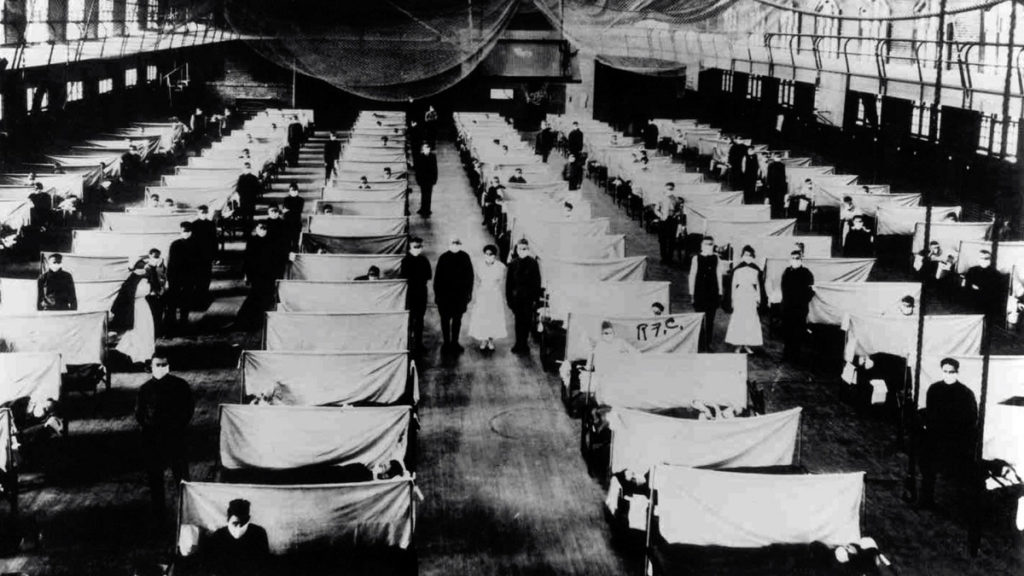
The Real Story
The flu of 1918 was waaaaay worse than Covid-19, and Covid-19 is pretty scary, so that’s saying something. For one thing, it hit young people especially hard, paradoxically because they had strong immune systems. The virus would enter the lungs, the immune system would react strongly, and the lungs would be destroyed in the process. This is one instance where being a healthy young person helped absolutely nobody.
Why did the 1918 influenza hit young people so hard? University of Arizona Professor Michael Worobey, an evolutionary biologist, has studied the origins of the 1918 pandemic virus, Influenza A, and the seasonal H1N1 (avian) flu virus variations that circulated between 1918 and 1957. Worobey’s research concluded that in the case of the Spanish flu, the population of 15-24-year-olds – those born from 1884 to 1903 – had no previous exposure to the H1N1 flu virus of 1918, and therefore lacked immunity, although they had immunity to H3N8, a subtype of what today is known as Type A flu. Those born before 1884 (Russian Flu) and after 1903 (the earliest mutation of the 1918 flu virus) , on the other hand, had acquired H1N1 immunity. Furthermore, vaccinations hadn’t yet been invented so there was no way to introduce and inoculate against known pathogens. Furthermore, a mutation in the genomes of the virus made it particularly virulent, allowing it to replicate in the host, especially the lung tissue, instead of just in it’s own cells.
So, we know the virus settled in the lungs, but the truly horrible part of it was that your lungs would fill up with mucus, and you’d suffocate on your own liquids. A dead giveaway of infection, even if a person wasn’t coughing or showing other signs, was that a lot of people were literally blue either on the entire body or on lesion-like spots. Because of the damage to the lungs, blood would often pour out of every orifice of the head, so by the end you suffocated on your own internal liquids.
The virus was so dangerous partly because it was like a juggernaut in the body once it found a host. There are (admittedly uncorroborated and unprovable) stories of people being in perfect health with no sign of any illness one day and dead by the next morning. An example of how quickly the virus worked is one of a mostly Inuit community of around 80 people in the remote area of Brevig Mission. Scientists and historians are not clear on how the virus managed to reach the isolated community, but within five days in November of 1918, 72 of the 80 community members had died from the virus.
From 1918 to 1920 it is estimated that 500 million people contracted the virus claiming at least 50 million deaths, though it’s hard to be sure of the casualties due to the speed in which the deaths accumulated. One thing is certain, the flu killed more of the population than WWI, more than the Bubonic Plague, more than 25 years of the HIV/AIDS crisis. The pandemic lowered the average life expectancy in the United States by more than 12 years. A comparable death rate has not been observed during any of the known flu seasons or pandemics that have occurred either prior to or following the 1918 pandemic.
THANK GOD WE ONLY HAVE COVID-19. I never thought I’d have a reason to say that, but here we are.
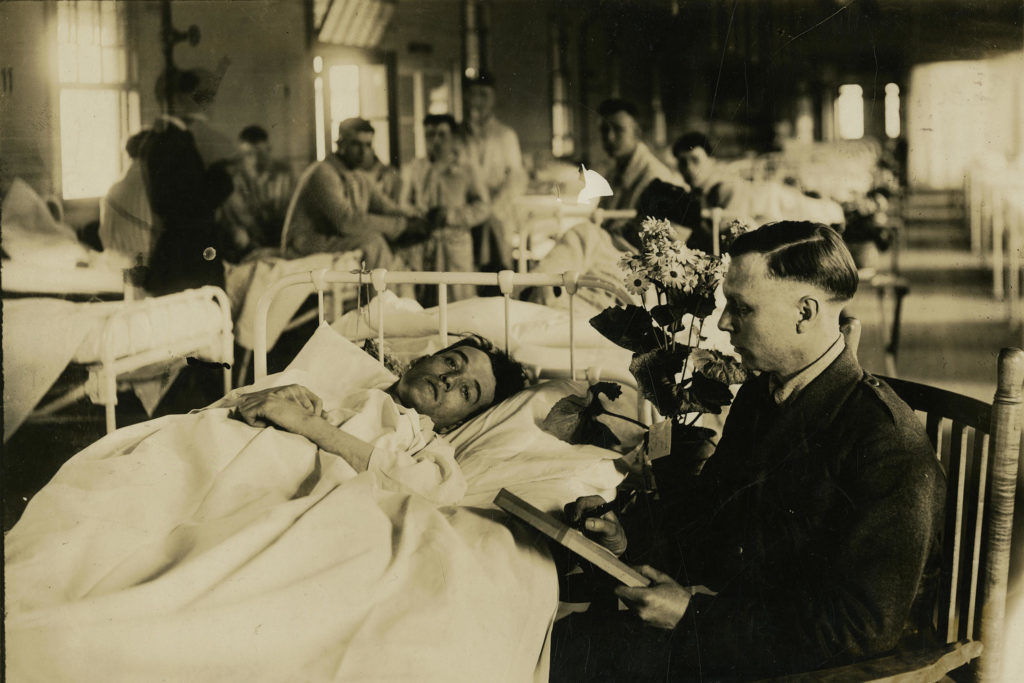
The First Cases
People are all over the map on where the flu started. Some suggest China, others suggest France, but we know that the first documented case of outbreak was in military barracks in Kansas.
Camp Funston was situated within Fort Riley, Kansas, a military training facility housing 26,000 or so army recruits, the young men packed into barracks. Soldiers dreaded the frigid winters and the gruelling hot summers as much as the severe dust storms in between.
On Monday, March 11, 1918, mess cook Private Albert Gitchell awoke feeling achy and hot, his throat burning terribly. Gitchell suited up and dragged himself down to the infirmary. With a fever over 103°F, Gitchell had chills as well as aches and pains just about everywhere.
As a precaution, Gitchell was ordered to the tent reserved for soldiers with potentially contagious conditions but he had been serving up meals to soldiers until the previous evening. A few hours after the Private Gitchell was admitted, Corporal Lee Drake came in with almost identical symptoms. Then, Sergeant Adolph Hurby showed up. One by one, men with fevers of 104°F, blue faces and horrendous coughs made their way to the infirmary. By midday, Camp Funston had 107 cases of the flu, a total of 522 reported within the first week alone, and a staggering 1127 by the time April rolled around. In the end, 46 of those afflicted at Fort Riley died.
Officials called it a pneumonia outbreak and chalked it up to the strange combination of conditions in Fort Riley that week. Not only had the camp been shrouded in a prairie dust storm, soldiers had been breathing in something even more noxious: putrid black ash created by tons of burning manure courtesy of the camp’s thousands of horses and mules. In retrospect, the fact that countless swine and poultry were also living in close proximity to the soldiers may be a more likely place to lay blame since pigs can be susceptible to avian influenza viruses — those strains responsible for most serious forms of flu — which can then mutate and be transmitted to humans.
As Camp Funston recovered, infected American soldiers, many just narrowly recovered from the illness, were shipped off to Europe to live in even more cramped quarters. And, unfortunately, they brought the flu with them, spreading it first to France, England, Germany and then Spain. It followed not only the movements of the troops, but also travelled rapidly along shipping and trade routes throughout the world.
Because of war, and, let’s face it, racism/xenaphobia/foolishness, the 1918 Flu had a lot of other super offensive names. Some highlights are: ‘Spanish Lady’, ‘French Flu’, ‘Naples Soldier’, ‘Purple Death’, ‘War Plague’, ‘Flanders Grippe’, ‘Kirghiz Disease’, ‘Black Man’s Disease’, ‘Hun Flu’, ‘German Plague’, ‘Bolshevik Disease’ or even the ‘Turco-Germanic bacterium criminal enterprise’.” Holy shit, that last one.
Medical & Government Response
President Woodrow Wilson said not one goddamn word about the virus. He was more concerned with keeping up with appearances of a strong and healthy army during WWI. With Spain being a neutral nation, they were one of the few pushing out information in the media, hence it being called the Spanish Flu. Most people didn’t know there was an incredibly deadly flu virus going around until their neighbors or family started dying.
The advice from the medical community was to quarantine, to wear masks, and to stay home if you had symptoms…sound familiar?
Dr. John Dill Robertson, Chicago health commissioner in 1918If you get it, stay at home, rest in bed, keep warm, drink hot drinks and stay quiet until the symptoms are past. Then continue to be careful, for the greatest danger is from pneumonia or some kindred disease after the influenza is gone.
In 1918, the surgeon general noted in a handbill that “a person who has only a mild attack of the disease himself may give a very severe attack to others.” People were also warned to stay away from salesmen peddling “cures” and to seek medical help from trained professionals. One such “cure” was quinine (predecessor of hydroxychloroquine, the anti-malarial drug Donald Trump showed an interest in recently). Other shills recommended “powders for internal disinfection” (another weird fuckin’ thing Trump said, you can’t make this shit up).
There’s a lot to be said about contributing factors in the outbreak, such as being at war and having troops traversing the globe and bringing illnesses back, lack of preparedness for a pandemic, and the limited availability of what we now consider standard health interventions, but the government’s lack of accountability in the US seems a particularly large if not the greatest contributor to the deaths of 675k Americans during the pandemic.
Second Wave
While the first wave was absolutely horrible, there was a slight reprieve during the summer months. People started thinking the worst of it was over, but a stronger strain of the virus proved to be even more deadly than the first. Some news stories blame this on lifting of the quarantine, but those measures weren’t introduced until the second wave. Likely it was related to WWI and the troops returning from their stations in countries where the pandemic protocols varied widely in efficacy. Because people had become so comfortable during the summer, a lot of cities scheduled parades for fall and winter, an infamous example being the Philadelphia WWI fundraising parade that gave thousands the deadly flu.
Anti-Mask Protests
Various initiatives were rolled out and varied by region. They included closing schools and places of public amusement, enforcing “no-spitting” ordinances, encouraging people to use handkerchiefs or disposable tissues and requiring people to wear masks in public. A lot of times it was upheld as most people framed it as “protecting the troops from becoming infected” but there was a good amount of blowback and shouts of “MAH FREEDOM” because people are dumb creatures.
As one Red Cross PSA put it, “the man or woman or child who will not wear a mask now is a dangerous slacker.”
Of course idiots complained that the masks were uncomfortable, because I guess suffocating on your own blood is more comfortable than a gauze(!) mask, and lots of people stopped giving a shit about it once the war ended. San Francisco even saw an Anti-Mask League form in their city.
There were a lot of concessions made for the material of the masks to try to get people to just fucking wear them. Some ladies in Seattle were sporting delicate masks made of chiffon. Other people were cutting holes in their gauze masks so they could smoke their cigarettes. Even with such lax restrictions on materials, people found a reason to complain. Some even suggested it created fear in the public…you know, kinda like people should feel in a pandemic.
Some cities put a $5 fine in place for neglecting to wear a mask in public, which, by today’s standards, would be the equivalent of $85. With the average weekly salary of most individuals being just over $13, I can understand why this made people salty. Officials struggled to enforce the initiatives and there was an unfortunate incident where a man who refused to wear a mask was shot as well as two bystanders. Basically, no one was handling this well.
San Francisco’s first masking order began in October and ended in November after the World War I armistice. In January, when flu cases began to surge again in San Francisco, the city implemented a second mask order. This time, the resistance was much more intense. A group of dissenters that included a few physicians and one member of the Board of Supervisors formed the “Anti-Mask League,” which held a public meeting with over 2,000 attendees.
Great-Aunt Elizabeth and the Spanish flu
Philadelphia Threw a WWI Parade That Gave Thousands of Onlookers the Flu
Covid-19
The Real Story
Coronaviruses are a family of viruses that can cause illnesses such as the common cold, severe acute respiratory syndrome (SARS) and Middle East respiratory syndrome (MERS). So what makes those coronaviruses different from SARS-CoV-2, the virus that causes COVID-19? Dr. Clayton Cowl, a pulmonologist and chair of Mayo Clinic’s Division of Preventive, Occupational and Aerospace Medicine, says that SARS-CoV-2 shares both similarities and differences with other coronaviruses.
“The name ‘coronavirus’ has to do with what the virus looks like under a microscope,” says Dr. Cowl. “‘Corona’ means crown. All coronaviruses have a similar structure. They are also ‘enveloped’ viruses, which means they are able to stick to surfaces, but are also able to be killed with disinfectants. The novel virus that causes COVID-19 is one-nine hundredth of a width of a piece of hair.”
“The virus is called ‘novel’ because it started with an animal population, was transmitted to a human and now can go from human to human. Our immune systems have never seen this particular strain of virus before, so we haven’t developed immunity. We don’t have a vaccine for it at this point. And similar to many of the other novel viruses, it has potential for worldwide distribution. We’ve seen this with the Middle East virus (MERS), with SARS and other viruses that we’ve heard about over time.”
Dr. Cowl says that SARS-CoV-2 is likely more contagious than the viruses that cause influenza and common cold because it is new to humans. Humans have no way to prepare for it, and their immune systems are not ready to fight it. This results in the virus causing more cellular damage and producing more inflammatory cells. For people with decreased immunity, due to medications, a specific condition, or from aging, the resulting COVID-19 disease is more serious.
Dr. Cowl says there is a lot not yet know about COVID-19, and how it will act in the future is uncertain. It’s too early to know if it will evaporate like H1N1 or SARS, or remain at a low level for years. He says the focus now is to minimize the spread of the virus and to help patients who have it.
How the virus that causes COVID-19 differs from other coronaviruses
Racializing a Fucking Virus
This morning a White House official referred to #Coronavirus as the “Kung-Flu” to my face. Makes me wonder what they’re calling it behind my back.
— Weijia Jiang (@weijia) March 17, 2020
Disease outbreaks are often racialized and made vehicles for nativist beliefs and ethnic hatreds. In 2020, some commentators continue to misleadingly and dangerously call Covid-19, the disease caused by the new coronavirus, the “Chinese flu” — a term that has helped to trigger anti-Asian harassment in the United States and Europe. That rhetoric has been encouraged by some conservative political leaders: House Minority Leader Kevin McCarthy prefers “Chinese coronavirus,” while Mike Pompeo insists on “Wuhan coronavirus.” President Donald Trump has frequently vowed to defend Americans against a “foreign virus.” As this March 17 tweet from a CBS reporter indicates, other, less-veiled terms appear to be circulating at the White House.
How Covid-19 began has become increasingly contentious, with the US and other allies suggesting China has not been transparent about the origins of the outbreak.
Donald Trump, the US president, has given credence to the idea that intelligence exists suggesting the virus may have escaped from a lab in Wuhan, although the US intelligence community has pointedly declined to back this up. The scientific community says there is no current evidence for this claim.
This follows reports that the White House had been pressuring US intelligence community on the claim, recalling the Bush administration’s pressure to “stove pipe” the intelligence before the war in Iraq.
What's the Problem with the China Narrative?
A specific issue is that the official origin story doesn’t add up in terms of the initial epidemiology of the outbreak, not least the incidence of early cases with no apparent connection to the Wuhan seafood market, where Beijing says the outbreak began. If these people were not infected at the market, or via contacts who were infected at the market, critics ask, how do you explain these cases?
Several theories have been promoted. The first, and wildest, is that scientists at WIV were engaged in experiments with bat coronavirus, involving so-called gene splicing, and the virus then escaped and infected humans. A second version is that sloppy biosecurity among lab staff and in procedures, perhaps in the collection or disposal of animal specimens, released a wild virus.
The accidental release of a wild sample has been the focus of most attention, although the “evidence” offered is at best highly circumstantial.
The Washington Post has reported concerns in 2018 over security and management weakness from US embassy officials who visited the WIV several times, although the paper also conceded there was no conclusive proof the lab was the source of the outbreak.
Le Duc, however, paints a different picture of the WIV. “I have visited and toured the new BSL4 laboratory in Wuhan, prior to it starting operations in 2017- … It is of comparable quality and safety measures as any currently in operation in the US or Europe.”
He also described encounters with Shi Zhengli, the Chinese virologist at the WIV who has led research into bat coronaviruses, and discovered the link between bats and the Sars virus that caused disease worldwide in 2003, describing her as “fully engaged, very open and transparent about her work, and eager to collaborate”.
Maureen Miller, an epidemiologist who worked with Shi as part of a US-funded viral research programme, echoed Le Duc’s assessment. She said she believed the lab escape theory was an “absolute conspiracy theory” and referred to Shi as “brilliant”.
When Peter Forster, a geneticist at Cambridge, compared sequences of the virus genome collected early in the Chines outbreak – and later globally – he identified three dominant strains.
Early in the outbreak, two strains appear to have been in circulation at roughly at the same time – strain A and strain B – with a C variant later developing from strain B.
But in a surprise finding, the version with the closest genetic similarity to bat coronavirus was not the one most prevalent early on in the central Chinese city of Wuhan but instead associated with a scattering of early cases in the southern Guangdong province.
Between 24 December 2019 and 17 January 2020, Forster explains, just three out of 23 cases in Wuhan were type A, while the rest were type B. In patients in Guangdong province, however, five out of nine were found to have type A of the virus.
“The very small numbers notwithstanding,” said Forster, “the early genome frequencies until 17 January do not favour Wuhan as an origin over other parts of China, for example five of nine Guangdong/Shenzhen patients who had A types.”
In other words, it still remains far from certain that Wuhan was even necessarily where the virus first emerged.
The ‘Chinese Flu’ Is Part of a Long History of Racializing Disease
Government Response
Most countries locked shit down pretty quickly (except America b/c freedom). Some amazing examples of immediate and effective control of the virus are South Korea (before the cult shit started it up again), New Zealand, Germany, and a lot of nations in Africa (that aren’t receiving the fanfare of similar successes in Europe). Africa took the lead in creating effective and affordable covid-19 testing kits that cost one dollar which is hoped to provide accurate results in ten minutes. By comparison, Euro-centric countries testing kits cost hundreds of dollars.
Senegal is in a good position because its Covid-19 response planning began in earnest in January, as soon as the first international alert on the virus went out. The government closed the borders, initiated a comprehensive plan of contact tracing and, because it is a nation of multiple-occupation households, offered a bed for every single coronavirus patient in either a hospital or a community health facility.
As a result, this nation of 16 million people has had only 30 deaths. Each death has been acknowledged individually by the government, and condolences paid to the family. You can afford to see each death as a person when the numbers are at this level. At every single one of those stages, the UK did the opposite, and is now facing a death toll of more than 35,000.
The US, by comparison, neglected to act when the first outbreaks were reported and neglected to order quarantining and to prepare for medical overload, so we are leading the world in both coronavirus cases and deaths. WE’RE #1!!!!
Coronavirus world map: which countries have the most Covid-19 cases and deaths?
Why are Africa’s coronavirus successes being overlooked? | Afua Hirsch
Antimask Protests
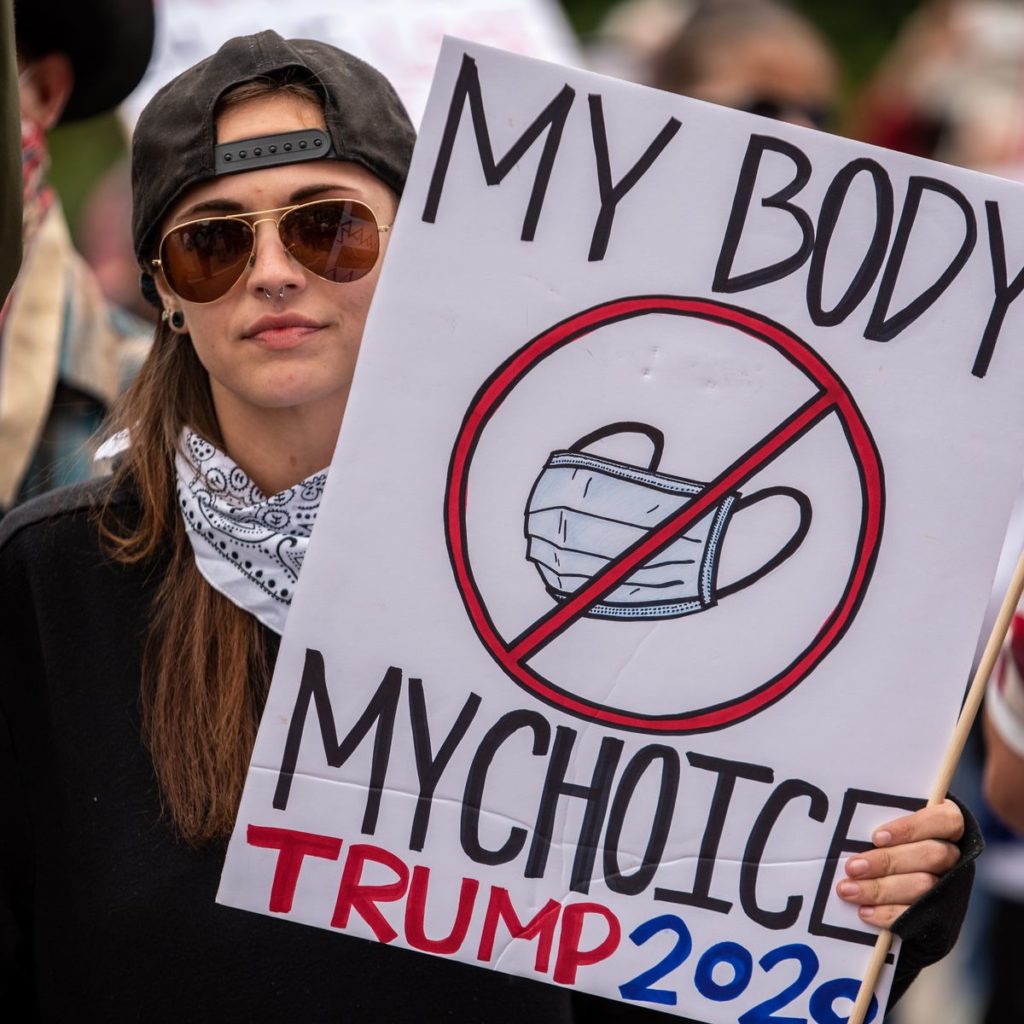
Of course, idiots are pulling this shit again. We don’t learn. People are saying it is a targeted move against their freedoms, that it negatively impacts oxygen absorption (it doesn’t), or simply complaining that IT’S NOT THEIR FAVORITE BECAUSE IT’S NOT SUPER COMFY GUYS. It’s also not super comfy to slowly die of hypoxia because the covid-19 virus is killing your lung tissue.
Early Re-opening Leading to Second Wave?
With the relaxation of the lockdown rules, warnings are being sounded about a possible resurgence of COVID-19 cases – a so-called second wave. The second wave of the Spanish flu pandemic in 1918-20 was particularly devastating, as was the second wave of the H1N1 epidemic in 2009-10. So what can be done to avoid a second wave of COVID-19?
As long as there are susceptible and infected people in the population, the virus can spread. Evidence is accumulating that the first wave of the epidemic resulted in only limited immunity, well below herd immunity levels. There are also pockets of a population in which the virus not only survives but continues to spread. The transmission in care homes now accounts for a large percentage of cases in many countries.
As the lockdown measures are relaxed, people are starting to interact more. This might result in increased values of R. But it is critical that the value of R is kept below or equal to one, as shown in the diagram below.
The epidemic could continue into autumn and winter when seasonal flu might be prevalent. While it appears that the SARS-CoV-2 virus is not strongly affected by weather, the healthcare system might become overwhelmed if COVID-19 and the flu strike at the same time.
On the plus side, preventive measures aimed at SARS-CoV-2 virus (such as masks and handwashing) might reduce the spread of the flu virus.
Finally, the virus could mutate resulting in a more infectious strain. Such a mutation might have caused the second middle wave of Spanish flu to be particularly severe. If something similar happened for SARS-CoV-2 virus, the resulting epidemic would dwarf the current outbreak even if the new R value was only four, compared with 10-12 for mumps or 12-18 for measles. Mumps and measles are only kept from spreading widely by vaccination.
Pandemic PTSD
What’s true of all the evils in the world is true of plague as well. It helps men to rise above themselves. Albert Camus, "The Plague"
Prior to the COVID-19 pandemic, nearly one in five of U.S. adults (47 million) reported having a mental illness in the past year, and over 11 million had a serious mental illness, which frequently results in functional impairment and limits life activities. Prevalence of depression and anxiety was also high: In 2017-2018, nearly 17 million adults and an additional 3 million adolescents had a major depressive episode in the past year. In 2018, nearly a third (32.5%) of adults reported feeling worried, nervous, or anxious on a daily, weekly, or monthly basis.
Deaths due to drug overdose have increased more than threefold over the past 19 years (from 6.1 deaths per 100,000 people in 1999 to 20.7 deaths per 100,000 people in 2018). In 2018, over 48,000 Americans died by suicide, and in 2017-2018, over ten million adults (4.3%) reported having serious thoughts of suicide in the past year.
During this unprecedented time of uncertainty and fear, it is likely that mental health issues and substance use disorders among people with these conditions will be exacerbated. In addition, epidemics have been shown to induce general stress across a population and may lead to new mental health and substance use issues.
In the 2003 SARS outbreak, we saw government reaction that was the best possible scenario for infectious disease outbreak through quick containment and widespread use of quarantine measures. One researcher stated, despite quick resolution, he found among quarantined persons a high prevalence of psychological distress, including symptoms of depression and posttraumatic stress disorder (PTSD).
One study on the mental health affects of riots, protests, and revolutions found that the prevalence of depression and PTSD among populations after collective actions is comparable to levels experienced after natural disasters and terrorist attacks. This was the case for populations directly and indirectly affected by such events, suggesting a “spillover effect,” as anxiety over a disruptive event ripples through communities. We see similar effects after natural disasters, where mental health consequences can include depression, PTSD, and substance use disorders.
With so many eyes focused on the stock market, it is possible to miss that the economic brunt of Covid-19 will likely be borne by low-wage, hourly workers, who can ill-afford the time away from work that containing the disease may necessitate. This will have consequences for health. Income is closely linked to health—physical and mental. There is, for example, a 10 to 15 year difference in life expectancy between Americans at the very bottom of the economic ladder and those at the very top, and income inequality has been linked with depression risk. Covid-19 could deepen this inequality over the long-term, even as, in the short-term, it undermines the peace of mind necessary for robust mental health, and compounds the challenges of people already prone to mental health struggles.
Another recent report, released Friday from the Well Being Trust, said the pandemic could lead to 75,000 additional “deaths of despair” from drug and alcohol misuse and suicide due to unemployment, social isolation, and fears about the virus.
“Our society is definitely in a collective state of trauma,” said Jonathan Porteus, PhD, a licensed clinical psychologist who oversees the crisis and suicide hotline in Sacramento, CA. Unlike posttraumatic stress disorder, which surfaces after a trauma has ended, the country is only starting to grapple with the pandemic’s psychological fallout, he said.
“We do see an emerging potential crisis,” said Karestan Koenen, PhD, a professor of psychiatric epidemiology at Harvard’s T.H. Chan School of Public Health, during an online forum this week.
Koenen, who has studied other major disasters, sees problematic differences this time, including how long-lasting the pandemic may become and how it has affected the whole world.
“We know that social support is so important to buffer the effects of disasters, to help pull people out of disasters, and here, we see that because of physical distancing … we’re sort of robbed of some of that social support, so that’s extra-challenging.
“In terms of this specific situation, we’re really treading new ground.”
WWII & Pandemic Denialism

WWII
World War I, also known as the First World War or the Great War, was a global war that lasted from 1914 to 1918. Contemporaneously described as “the war to end all wars”, it led to the mobilization of more than 70 million military personnel, including 60 million Europeans, making it one of the largest wars in history. It is also one of the deadliest conflicts in history with an estimated 9 million combatant deaths and 13 million civilian deaths as a direct result of the war, while resulting genocides and the related 1918 influenza pandemic caused another 17–100 million deaths worldwide. After the sinking of American merchant ships by German submarines, the declaration by Germany that its navy would resume unrestricted attacks on neutral shipping, and the revelation that Germany was trying to incite Mexico to make war on the United States, the U.S. declared war on Germany on 6 April 1917. Trained American forces would not begin arriving at the front in large numbers until mid-1918, but ultimately the American Expeditionary Force would reach some two million troops.
Woodrow Wilson's Suppression of Information
Thomas Woodrow Wilson served as the 28th president of the United States from 1913 to 1921. As president, he oversaw the passage of progressive legislative policies unparalleled until the New Deal in 1933. He also led the United States into World War I in 1917, establishing an activist foreign policy known as “Wilsonianism.” He was the leading architect of the League of Nations.
Woodrow Wilson is one of the most controversial presidents in American history. While he is regarded as one of the best presidents by popular poll and most American history books, he is classified as overrated and sometimes even outright dangerous by contemporaries and some historians. Critics note that Wilson not only refused to support women’s suffrage, added to racial segregation, interfered in Central American government despite being supposedly “anti-imperialist”, and only passed labor laws to secure the vote as he had previously voted against them. In short, he was a fuckin’ hypocrite. That being said, he made major strides in protecting average citizens from big corporations, shortened the work day, and mandated a minimum wage, so, even if it was under false pretenses, he got some shit done in labor reform. I can’t imagine it’s easy to be 100% morally upright in a presidential setting, he goddamn failed at it as it pertains to the 1918 Flu…so let’s get into his particular brand of dangerous bullshit ™. P to the S…he used the term “New World Order” in talking about creation of the League of Nations, some super Illuminati shit.
Espionage Act of 1917
Anti-Sedition Act
The Espionage Act was reinforced by the Sedition Act of the following year, which imposed similarly harsh penalties on anyone found guilty of making false statements that interfered with the prosecution of the war; insulting or abusing the U.S. government, the flag, the Constitution or the military; agitating against the production of necessary war materials; or advocating, teaching or defending any of these acts. Both pieces of legislation were aimed at socialists, pacifists and other anti-war activists during World War I and were used to punishing effect in the years immediately following the war, during a period characterized by the fear of communist influence and communist infiltration into American society that became known as the first Red Scare (a second would occur later, during the 1940s and 1950s, associated largely with Senator Joseph McCarthy). Palmer–a former pacifist whose views on civil rights radically changed once he assumed the attorney general’s office during the Red Scare–and his right-hand man, J. Edgar Hoover, liberally employed the Espionage and Sedition Acts to persecute left-wing political figures.
There are also stories of the post office being allowed to open the letters of private citizens to police for seditious materials and of civilians being arrested and fined for the crime of dissension of the war efforts.
One of the most famous activists arrested during this period, labor leader Eugene V. Debs, was sentenced to 10 years in prison for a speech he made in 1918 in Canton, Ohio, criticizing the Espionage Act. Debs appealed the decision, and the case eventually reached the U.S. Supreme Court, where the court upheld his conviction. Though Debs’ sentence was commuted in 1921 when the Sedition Act was repealed by Congress, major portions of the Espionage Act remain part of United States law to the present day.
Committee on Public Information (Propaganda)
When the United States declared war on Germany in April 1917, President Woodrow Wilson faced a reluctant nation. Wilson had, after all, won his reelection in 1916 with the slogan, “He kept us out of the war.” To convince Americans that going to war in Europe was necessary, Wilson created the Committee on Public Information (CPI), to focus on promoting the war effort.
To head up the committee, Wilson appointed a brilliant political public relations man, George Creel. As head of the CPI, Creel was in charge of censorship as well as flag-waving, but he quickly passed the censor’s job to Postmaster General Albert S. Burleson. The Post Office already had the power to bar materials from the mail and revoke the reduced postage rates given to newspapers and magazines.
One of the recruits was Edward L. Bernays, a nephew of Sigmund Freud and a pioneer in theorizing about human thoughts and emotions.
“The conscious and intelligent manipulation of the organized habits and opinions of the masses is an important element in democratic society,” Bernays wrote a few years after the war. “Propaganda is the executive arm of the invisible government.”
Having worked in Wilson’s campaign, was able to quickly amass an army of 150,000 volunteers and created a well-oiled propaganda machine by creating divisions.
- The Speaking Division recruited 75,000 specialists who became known as “Four-Minute Men” for their ability to lay out Wilson’s war aims in short speeches.
- The Film Division produced newsreels intended to rally support by showing images in movie theaters that emphasized the heroism of the Allies and the barbarism of the Germans.
- The Foreign Language Newspaper Division kept an eye on the hundreds of weekly and daily U.S. newspapers published in languages other than English.
- Another CPI unit secured free advertising space in American publications to promote campaigns aimed at selling war bonds, recruiting new soldiers, stimulating patriotism and reinforcing the message that the nation was involved in a great crusade against a bloodthirsty, antidemocratic enemy.
- The Division of Pictorial Publicity was led by a group of volunteer artists and illustrators. Their output included some of the most famous war-time appeals, including the portrait by James Montgomery Flagg of a Uncle Sam with the caption “I WANT YOU FOR THE U.S. ARMY!” Other ads showed cruel “Huns” with blood dripping from their pointed teeth, hinting that Germans were guilty of bestial attacks on defenseless women and children. “Such a civilization is not fit to live,” one ad concluded.
Creel was not happy about his work being called propaganda, choosing instead to describe it as a battle of perceptions. “The war was not fought in France alone,” he wrote in 1920, after it was all over, describing the CPI as “a plain publicity proposition, a vast enterprise in salesmanship, the world’s greatest adventure in advertising.”
CPI created a plan to “bury the journalists in paper”. This plan took advantage of overworked journalists who were pressured to keep up with a fast news pace during war times by delivering pre-written, printable editorials. During the 20 months of the U.S. involvement in the war, the CPI issued nearly all government announcements and sent out 6,000 press releases written in the straightforward, understated tone of newspaper articles. It also designed and circulated more than 1,500 patriotic advertisements. In addition, Creel distributed uncounted articles by famous authors who had agreed to write for free. At one point, newspapers were receiving six pounds of CPI material a day.
Most editors were on board to print the propaganda. These government-written articles appeared in at least 20,000 newspaper columns each week. The CPI also issued a set of “voluntary guidelines” for U.S. newspapers, to help those patriotic editors who wanted to support the war effort (with the implication that those editors who did not follow the guidelines were less patriotic than those who did).
On June 14, 1917, Wilson used the occasion of Flag Day to paint a picture of American soldiers about to carry the Stars and Stripes into battle and die on fields soaked in blood. He argued that the world must be made safe for democracy, but with his 1917 Flag Day speech, he trained the country’s sights on a less exalted goal: the destruction of the government of Germany, which was bent on world domination.
Thousands of nationalist vigilantes began to harass pacifists, socialists, and German immigrants who were not citizens as a direct result of the CPI’s propaganda. Even the most casual expression of doubt about the war could trigger a beating by a mob, and the humiliation of being made to kiss the flag in public. Americans who declined to buy Liberty Bonds sometimes awoke to find their homes streaked with yellow paint. Several churches of pacifist sects were set ablaze. Men suspected of disloyalty were tarred and feathered, and a handful were lynched. Most of the violence was carried out in the dark by vigilantes who marched their victims to a spot outside the city limits, where the local police had no jurisdiction. Perpetrators who were apprehended were rarely tried, and those tried were almost never found guilty. Jurors hesitated to convict, afraid that they too would be accused of disloyalty and roughed up.
How Woodrow Wilson’s Propaganda Machine Changed American Journalism
When the U.S. Used ‘Fake News’ to Sell Americans on World War I
Worldwide Suppression of Critical Pandemic Information
Warring nations covered up the flu to protect morale among their own citizens and soldiers, but also because they didn’t want enemy nations to know they were suffering an outbreak. The flu devastated General Erich Ludendorff’s German troops so badly that he had to put off his last offensive. The general, whose empire fought for the Central Powers, was anxious to hide his troops’ flu outbreaks from the opposing Allied Powers.
Across the warring factions, a consistent theme in reports is “hey, it’s not that bad, it’s getting weaker with every transmission!” Super fuckin’ helpful, guys.
Treaty of Versailles: A Giant Fucking Failure
Both the timing and venue of the Paris Peace Conference that led to the agreement on terms of the treaty had been carefully calculated by the French. The start date, January 18, 1919, was the anniversary of the day in 1871 when Wilhelm I had been proclaimed as emperor of the new German Reich in the Hall of Mirrors. This had been a deliberate act of political theatre by his chancellor, Count Otto von Bismarck, to rub French noses in the degradation of their defeat in the Franco-Prussian War. And so, after victory in WWI, the French formally administered the Reich’s last rites in the place where it had been born. The French, in particular, wanted Germany to pay a heavy price for the war, including loss of territory, disarmament and payment of reparations, while the British saw Wilson’s plan as a threat to their supremacy in Europe.
Taken as a whole, the treaties concluded after World War I redrew the borders of Europe, carving up the former Austro-Hungarian Empire into states like Yugoslavia, Poland and Czechoslovakia. As Neiberg puts it: “Whereas in 1914, you had a small number of great powers, after 1919 you have a larger number of smaller powers. That meant that the balance of power was less stable.”
Five long months later, on June 28—exactly five years after the assassination of Archduke Franz Ferdinand and his wife in Sarajevo—the leaders of the Allied and associated powers, as well as representatives from Germany, gathered in the Hall of Mirrors at the Palace of Versailles to sign the final treaty. By placing the burden of war guilt entirely on Germany, not equally imposing guilt on the other instigators such as the arguably more influential and destructive Austria-Hungary, imposing harsh reparations payments and creating an increasingly unstable collection of smaller nations in Europe, the treaty would ultimately fail to resolve the underlying issues that caused war to break out in 1914, and help pave the way for another massive global conflict 20 years later. Most Germans were furious about the Treaty of Versailles, calling it a Diktat (dictated peace) and condemning the German representatives who signed it as “November criminals” who had stabbed them in the back
Meanwhile, Germany’s economic woes, exacerbated by the burden of reparations and general European inflation, destabilized the Weimar Republic, the government established at the end of the war. Due to lasting resentment of the Versailles Treaty, the National Socialist (Nazi) Party and other radical right-wing parties were able to gain support in the 1920s and early ‘30s by promising to overturn its harsh provisions and make Germany into a major European power once again.
The Versailles Treaty forced Germany to give up territory to Belgium, Czechoslovakia and Poland, return Alsace and Lorraine to France and cede all of its overseas colonies in China, Pacific and Africa to the Allied nations. In addition, it had to drastically reduce its armed forces and accept the demilitarization and Allied occupation of the region around the Rhine River. Most importantly, the treaty placed all blame for inciting the war squarely on Germany, not Austria, and forced it to pay several billion in reparations to the Allied nations. In his memoir, U.S. President Herbert Hoover went so far as to blame reparations and the resulting destabilization of the European economy for causing the Great Depression.
John Maynard Keynes, economist and disillusioned member of the British delegation in Paris, delivered the most unapologetic indictment of the Versailles Treaty. In The Economic Consequences of the Peace, published in December 1919, he called the treaty a “Carthaginian peace” (referencing the total subjugation imposed on Carthage by Rome), with a “policy of reducing Germany to servitude for a generation” thereby causing “the decay of the whole civilized life of Europe”.
And despite the loss of German territory, “there were plenty of people who understood as early as 1919 that the map actually gave Germany some advantages,” Neiberg points out. “It put small states on Germany’s borders, in eastern and central Europe. It eliminated Russia as a direct enemy of Germany, at least in the 1920s, and it removed Russia as an ally of France.
The war guilt clause was more problematic. “You have to go back to 1914, when most Germans believed they had entered the war because Russia had mobilized its army,” explains Neiberg. “To most Germans in 1919, and not just those on the right, blaming Germany specifically for the war made no sense. Especially when they did not put a war guilt clause on Austria-Hungary, which you could reasonably argue were the people that actually started this.”
Conspiracy Theories
Allied countries suggested that the Germans and their new biological weapons — namely, mustard gas — were to blame. At one point, members of the American government even suggested that the popular new “wonder-drug,” Aspirin, and its German drug-company manufacturer, Bayer, were to blame in some sort of smallpox-infected-blanket-type scheme.
Artist Jordan Baseman delved into newspaper archives to find traces of peoples’ everyday experiences of the pandemic while researching for ‘Radio Influenza’, a digital artwork marking the centenary of the Spanish flu. He found that: “The flu was blamed on foreigners (anywhere in the world, not just the UK), on Jewish people, on dancing, on jazz music, on the bombing of the soil as a result of the war, and on pretty much anything else you could think of.”
One of the most dramatic features of the Spanish flu virus was the psychosis that accompanied infection for many victims – from mild hallucinations to severe delirium, and even extreme violence. Baseman found that this known symptom was used by some as ‘fake news’ to try to hoodwink those in authority:
“Influenza was often used as a reason by people as an excuse to carry out crimes. The flu took the blame for… bad behaviour, of a less severe variety: petty theft, truancy, irrational behaviours and any out-of-character and impulsive acts. Sometimes the flu was a genuine and valid reason for some calamity, but often times, the flu seems to be used as a dodge.”
The most widely spread theory for Americans centered around the intercepted German Submarines. People insisted that they were carrying biological weapons and released bacteria into the sea and air, thereby essentially poisoning the American population.
Plandemic: Everyone's an "Expert"
Dissemination of Information on the Internet
Our ability to gate-keep information through trained scholars and scientists has ended with the, admittedly revolutionary and overall positive, invention of the internet. In order to post a theory online for anyone to view, you don’t have to study for 6-8 years, spending up to three years in low or unpaid labor under an experienced guide and another three years creating and defending research and or scientific study that will be reviewed by people with more experience than you. It doesn’t matter if you are educated in the matters you are reviewing at all, in fact. Can you get to Google? Congratulations, you’re a scientist, medical doctor, psychologist, historian…whatever your lil ego desires. Furthermore, this variety of viewpoints and “facts” of varying reliability creates distrust even when someone is reading the research of professional sources.
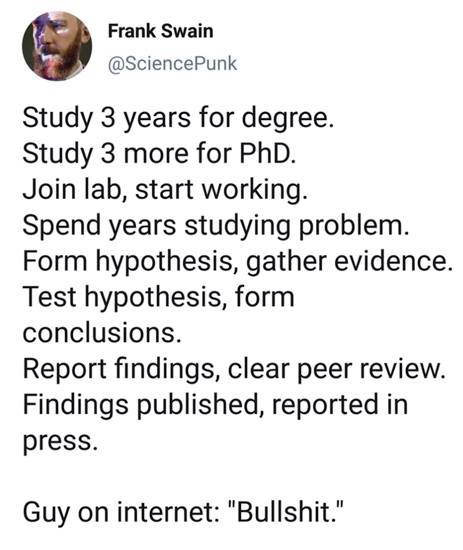
Distrust of Institutions
More recent pandemics have seen the rise of their own conspiracy theories, ones that formed in response to underlying concerns as much as they did to a virus or disease. “AIDS denialists,” for example — people who believe that HIV does not cause AIDS — were responding not just to AIDS, but to the context of AIDS in the United States of the 1980s, a disease that seemed to kill the most vulnerable and most despised in society with little attention or care from mainstream authority figures. That led some people, already experienced in distrusting institutions that had only served to disadvantage and oppress them, to distrust them even more in the face of a crisis.
As Charlie Anders detailed in the story of one former denialist in Gizmodo in 2015:
At this time, [Stephen] Kovacev had been a gay rights activist for a dozen years, having moved to New York’s Christopher Street in the wake of the Stonewall riots. He’d survived protests, clashes with the police, and “brutal” treatment from a homophobic medical establishment that treated him “like a pariah” when he sought treatment for anal warts. After all of this, plus Watergate and Vietnam, said Kovacev, “how could you trust anything that came from any institution?” So Kovacev was skeptical about a neat and tidy explanation for AIDS—and then he heard that a reputable scientist, Peter Duesberg at U.C., Berkeley, was saying he believed that HIV was a harmless virus, that had nothing to do with causing AIDS. (Duesberg still believes this.) So Kovacev and his friends didn’t know what to think. “We weren’t denialists,” Kovacev said of his fellow activists at the time. “We just didn’t fucking trust anybody.”
Donald Trump: Master Conspiracy Theorist
Although celebrity culture has been nourishing conspiracy theories for some decades, it appears that more recent political events have increased the popularity of conspiracy theories in the Western world. As early as 1964 Richard Hofstadter (2012) studied the so-called “paranoid style” in American politics. But, many observers converge on the idea that Donald Trump’s political ascendency has marked a new era of conspiratorial thinking in the United States and other countries under its sphere of influence (Hellinger 2019). Before being a politician, Trump was a celebrity; and thus, both roles have managed to influence his followers into making conspiracy theories more popular. He is on record for giving credibility to numerous conspiracy theories: global warming is a hoax, Barack Obama was not born in the United States, Rafael Cruz participated in J.F. Kennedy’s assassination, Bill Clinton ordered the assassination of Vince Foster, Antonin Scalia was murdered, vaccines cause autism.
Medical conspiracy theories: cognitive science and implications for ethics
Plandemic: Bad Theories, Bad Doctors
Lorem ipsum dolor sit amet, consectetur adipiscing elit. Ut elit tellus, luctus nec ullamcorper mattis, pulvinar dapibus leo.
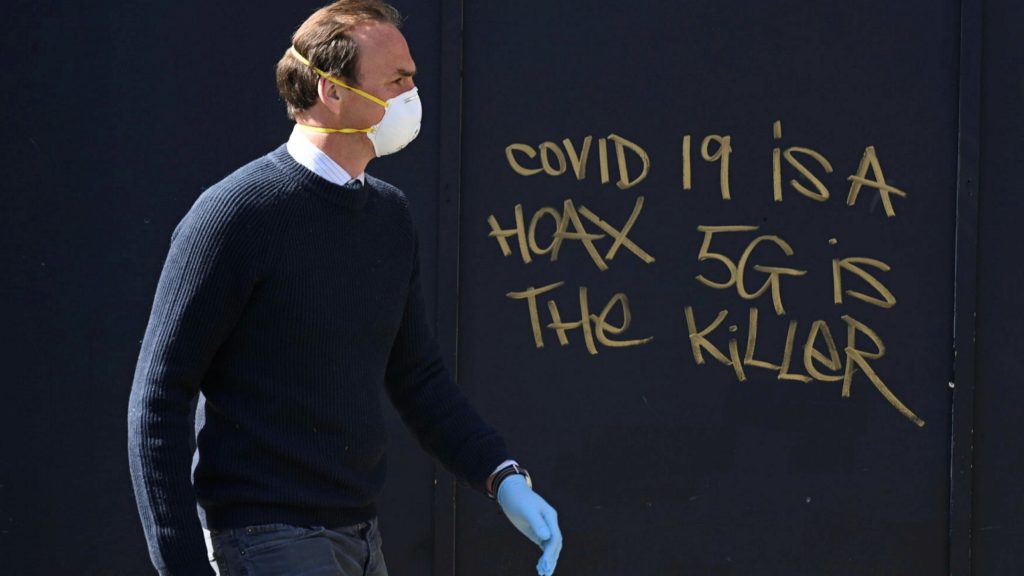
The 5G Link
These conspiracy theories argue that the spread of the virus from the epicentre of the pandemic in Wuhan, China, is linked to the large number of 5G towers in the city. In reality, a 5G network is not even fully deployed there. Other theories falsely claim that the waves emitted by the 5G infrastructure would weaken our immune system. One doctor even claimed that the coronavirus is, essentially, a toxin that is released from our bodies due to the radiation from the 5G Towers.

The Shady Doctor That Started It All
In the video, Dr. Thomas Cowan claims viruses are the waste from cells that are poisoned. Some of the poisoning, he said, comes from electromagnetic fields.
Cowan is an American holistic medical practitioner who trained as a physician.
He is currently operating on probation with the medical board in California and has limits on his practice after a 2017 complaint to the state medical board that, among other things, he had offered an unlicensed drug to a breast cancer patient without informing her it wasn’t approved for use.
He also never saw the patient in person nor did he review her full medical file, according to documents from the Medical Board of California detailing why Cowan was to be disciplined.
Cowan has authored several books that promote ideas contrary to conventional medical wisdom including one that argues against the immunization of children.
Cowan’s viral theory on 5G and the spread of coronavirus was recorded earlier this month in Tucson, Ariz., at a conference put on by a group called the Humans for Humanity Coalition. That event was also attended by people opposed to vaccines, including discredited researcher Andrew Wakefield, whose study linking the MMR shot to autism in children was retracted in 2010.
The original video was uploaded to YouTube on March 12. It quickly went viral and racked up 16,000 shares and 390,000 views within a week. Many more copies of the video exist online, some with translations in different languages. At least five other YouTube users have uploaded it to their channels.
The video has also been uploaded by more than a dozen Facebook pages, as well as on Instagram and Twitter. It was notably shared on Instagram by American singer Keri Hilson to her 2.3 millions followers. After it sparked controversy, Hilson deleted her post.
In the video, Cowan claims that viruses are simply the byproduct of a cell that has been poisoned.
One of Canada’s top virologists says that isn’t so.
“Viruses are not just debris,” said Jason Kindrachuk, a virologist and Canada research chair in emerging viruses at the University of Manitoba.
“Viruses don’t just get created as a way to deal with poison.”
Viruses, Kindrachuck said, are small pieces of genetic material surrounded by a protein coat.
*”*The virus basically is essentially inert until it basically binds specifically to certain types of cells,” Kindrachuck said.
“Once it gets inside of our cell, it releases its genomic material and then it uses basically our host cell machinery to create more and more and more copies of itself.”
As proof that the cause of the global pandemic is not debris, Kindracuk points to various scientific investigations into the coronavirus, including the fact researchers have been able to take it apart physically and put the virus sequence back together and use it to infect primates.
*”*We’ve been able to put that virus into rhesus macaques, which are a non-human primate and are very similar to humans in terms of how they respond to many different pathogens and illnesses,” said Kindrachuk.
“Those animals get sick with something that looks kind of like mild COVID-19. So I think the data is so overwhelmingly valid.”
Kindrachuk also said he has seen variations of the theory that 5G causes illness emerge long before the COVID-19 outbreak.
**”**It’s actually been something that the anti-vax community has used fairly frequently as part of their argument against vaccination. So I’m not surprised. I’m disenchanted by the fact that even during a pandemic and a global health crisis, that this stuff keeps resurfacing,” Kindrachuck said
Many other claims made by Cowan in the video don’t hold up to scrutiny.
For example, he said the 1918 Spanish flu pandemic coincided with the worldwide introduction of radio, proving that radio waves caused the outbreak. However, the first commercial radio station, XWA from Montreal, started broadcasting in 1920.
He also claims that the Boston health department tried to experiment with the 1918 flu virus by purposefully infecting healthy people with the mucus of infected patients, and that the result was that the healthy people didn’t get sick. There is no proof this ever happened. The only mentions of this story we found on the internet were either on Cowan’s site or on forums mentioning Cowan’s newsletter.
Indeed, health authorities at the time, in Boston and elsewhere, were quite aware that the outbreak was caused by a virus that could easily spread. For example, authorities in Boston asked women who were dating sailors, one of the first groups to introduce the outbreak to the U.S. mainland, not to kiss them so as not to catch the disease
Viral video claiming 5G caused pandemic easily debunked | CBC News
History of Radiation Paranoia
Despite the fact that pretty much everything contains some amount of radiation and the widely available knowledge of ionizing vs non-ionizing radiation and the strict limits most governments place on how much radiation the public can come into contact with, people like to believe that every new invention that utilizes radio frequencies is THE ONE THAT IS GOING TO KILL US ALL. During the 1918 Flu, the newly accessible electricity and lightbulbs were the cause of the virus. With every iteration of new technology, that technology would negatively impact the health of the people using it. Everything from AM radios to WiFi has been the topic of concern in causing cancer.
Evidence Supports Claim that 5G isn't Dangerous
I have a ton of resources that state not only that 5G is not operating in dangerous radiation levels, but that in areas where coronavirus specifically took off, 5G was not widely used. There are literally thousands of peer-reviewed studies that confirm the safety of 5G.
Radiofrequency energy from wireless devices and networks, including radiofrequencies used by 5G, has not been shown to cause health problems, according to the international scientific community. To cite one example, the Food and Drug Administration said, “Based on our ongoing evaluation of this issue, the totality of the available scientific evidence continues to not support adverse health effects in humans caused by exposures at or under the current radiofrequency energy exposure limits.”
5G Paranoia is Dangerous
There are plenty of people who fully buy into the 5G paranoia to the point of actively trying to destroy towers, menacing the workers who try to maintain or repair said towers, and threatening people with assumed involvement.
James Vincent, "Something In the Air" - The VergeMost incidents could be classified as harassment. Shouted insults, death threats, and the like. But others were more violent. Razor blades and needles had been hidden behind posters on telephone poles, waiting to catch unwitting hands. Attackers had set cellphone masts on fire and shared the videos on social media to the applause of fellow conspiracists. According to figures shared with The Verge by industry body Mobile UK, there were more than 200 incidents of abuse against telecoms engineers since March 30th and more than 90 arson attacks against mobile infrastructure.
How Do You Defend the Obvious?
“People have an epistemic need to know the truth and they also have an existential need to feel safe,” says Dr. Karen Douglas, a researcher who studies the psychology of conspiracy theories. “In times of crisis, these needs are unmet so conspiracy theories can seem appealing.”
Even as companies are racing to develop a vaccine for Covid-19, conspiracy theorists may prevent people from taking them. Anti-vaxxer activists have pounced on Covid-19, protesting against vaccine development efforts and teaming with protesters fed up with stay-at-home orders. “Experimental research also shows that exposure to conspiracy theories increases vaccine hesitancy,” says Dr. Douglas. And polling bears that out: In a recent poll, 1 in 5 Americans said they would not take a vaccine for the coronavirus if it became available.
Indefinite Scientific Language
The language of scientists is often not strictly defined and this allows for the inevitable changes in understanding, new and better working theories, and additional information that could change the details of how theories work. Unfortunately, people don’t seem to take this in the way it’s meant and use the language as proof that scientists just don’t know what they are talking about. Furthermore, scientists will often answer specific questions in a way that people take as admitting to the validity of conspiracy theories.
The Language of Conspiracy Theories
The aim of doublespeak is not to communicate a truth, but to transfer a lie in a way that is indistinguishable from the truth by way of complicated verbiage. William Lutz defined four distinct kinds in his book “Doublespeak.”
4 Kinds: Euphemism, Jargon, Gobbledygook, and Inflated Language
The first is the simple euphemism, in which a word is used to soften a cruel reality. This use may be benign, as when we say “passed on” or “sleeping with.” The second is jargon, which is useful within a trade or profession, but which may be used to keep outsiders out. The third is gobbledygook, the use of big words and strings of nouns so beloved by bureaucracy. The fourth is inflated language designed to make the ordinary seem extraordinary.
Jargon can refer to the specialized language of a profession or field of study (a neutral term in the usage). It can also describe language which is artificial or pretentious, more complex than it needs to be, marked by euphemism, vagueness and insincerity. “Doublespeak” is jargon at its worst: language designed to deceive by means of confusion.
Gobbledygook is often called word-salad. It sounds like it should make sense but if you’re caught off-guard it might be challenging to sift through the language in order to see that the statement doesn’t make sense.
The fourth type of doublespeak, inflated language, is perhaps the most common and is the opposite of the euphemism. Inflated language is designed to “…make the ordinary seem extraordinary; to make everyday things seem impressive.” In relatively harmless settings, this is where garbage men might refer to themselves as “sanitation engineers”, or where used cars are called “previously distinguished vehicles.” Lutz then points out the more nefarious uses of inflated language, such as when a fire in a nuclear power plant was described as a “rapid oxidation.”Lutz notes the prolixity of what he calls “weasel words” in advertising. These are words that seem to make a claim of superiority, but actually make no claim at all. Among them are better (better than what?); helps (as in helps fight tooth decay); virtually (which really means not quite, or not by a long shot); new and improved (since when and how much?); acts fast (acts to do what?).
Logical Fallacies
- Ad Hominem – personal attack
- Appeal to Authority – works by stating that the argument is backed up by an authority (or an assumed authority) without giving relevant evidence
- Straw Man – arguing against the assumed position of your opponent in such a way as to easily dismantle the argument you’ve created for them
- Appeal to Ignorance – the premise that we can’t prove the point so it could potentially be true or false. “We have no real evidence that ghosts DON’T exist, as their energy is difficult to record.”
- False Dichotomy – reducing the argument to only two options limiting the possibilities of more options
- Slippery Slope – takes an argument from a reasonable standpoint to a ridiculous one by way of linking hypothetical actions
- Circular Reasoning – “proves” the argument by repeating the argument.
- Word Salad – use of intricate, obscure, or occulted language to speak in such a way as to make the other person feel inadequate to respond … mainly because it doesn’t make sense.
- Bandwagon – something is right, true, or good because a lot of people believe it.
- Red Herring – a clever but unrelated argument that distracts you from the real discussion
Social Ramifications
of Conspiracy Theories
It’s not unusual for people to become so enraged about their perceived “proof” of the legitimacy of whatever conspiracy theories they are buying into and they inflict that rage upon innocent folks who happen to have been the target of theorists. We have all probably heard about the crisis actors conspiracy theories involving shooting sprees, but it’s one thing to believe these theories and quite another to think it’s ok to target, let’s say, the parents of Sandy Hook victims and to tell them they are liars and their children who died never really existed. People torment the targets of these conspiracy theories and the danger inherent in this harassment cannot be understated.

